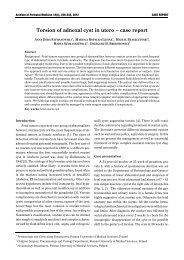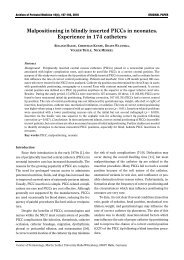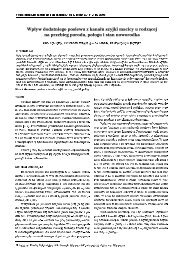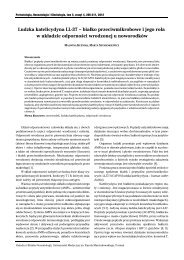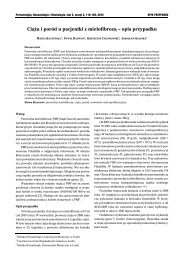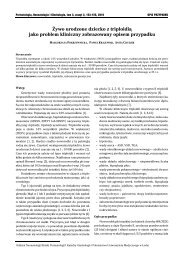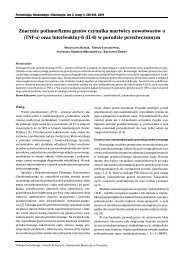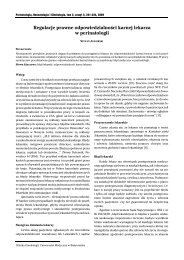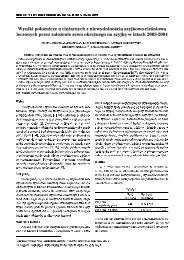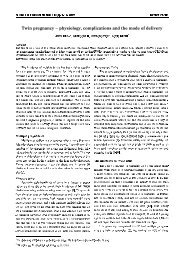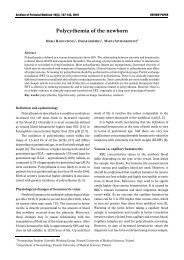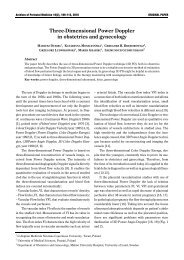Hysterosalpingo-contrast-sonography (HyCoSy) - a novel approach to
Hysterosalpingo-contrast-sonography (HyCoSy) - a novel approach to
Hysterosalpingo-contrast-sonography (HyCoSy) - a novel approach to
Create successful ePaper yourself
Turn your PDF publications into a flip-book with our unique Google optimized e-Paper software.
Abstract<br />
<strong>Hysterosalpingo</strong>-<strong>contrast</strong>-<strong>sonography</strong> (<strong>HyCoSy</strong>)<br />
– a <strong>novel</strong> <strong>approach</strong> <strong>to</strong> female upper genital tract imaging<br />
and tubal patency assessment in outpatient clinic<br />
RAFAŁ D. KOCYŁOWSKI, GRZEGORZ H. BRĘBOROWICZ<br />
15% of couples in reproductive age are affected by the inability <strong>to</strong> conceive and bear a child. Ana<strong>to</strong>mical disturbances are<br />
Approximately<br />
for 35-40% of female subfertility. Frequent organic causes of sterility and infertility are linked <strong>to</strong> the fallopian pathology. Standard<br />
responsible<br />
screening procedures of infertility include imaging techniques. Tubal patency is routinely assessed by hysterosalpingography (HSG)<br />
female<br />
diagnostic hysteroscopy and/or laparoscopy. Other technologies are nowadays intensively investigated <strong>to</strong> obtain the satisfac<strong>to</strong>ry balance<br />
and<br />
diagnostic/therapeutic accuracy and cost-effectiveness. Such a promising <strong>novel</strong> method seems <strong>to</strong> be hysterosalpingo-<strong>contrast</strong>-<strong>sonography</strong><br />
of<br />
which is based on the ultrasonographic (US) evaluation of a female pelvis with <strong>contrast</strong> media substances infused intrauterine.<br />
(<strong>HyCoSy</strong>),<br />
could be performed on outpatient basis in many cases, reducing the need for a diagnostic hysteroscopy and/or laparoscopy. However, disten-<br />
It<br />
of uterine cavity with <strong>contrast</strong> medium used during <strong>HyCoSy</strong> procedure may be associated with a kind of unpleasant sensation, discomfort<br />
tion<br />
even unacceptable pain. The superiority of ultrasonographically based <strong>HyCoSy</strong> occurs in terms of the lack of ovarian irradiation and<br />
or<br />
allergy due <strong>to</strong> iodinated <strong>contrast</strong> used during HSG. Additionally <strong>HyCoSy</strong> enables scanning of the uterus and ovaries at the same time<br />
avoiding<br />
is not available in HSG. <strong>HyCoSy</strong> showed concordance with laparoscopy in 85.2% while HSG in 84.1%. New <strong>contrast</strong> media for ‘harmonic<br />
which<br />
in <strong>contrast</strong>-specific scanning and organ-specific <strong>contrast</strong> agents will significantly improve diagnostic possibilities in the nearest future.<br />
imaging’<br />
Key words: sterility and infertility, female pelvis imaging, tubal patency assessment, hysterosalpingography (HSG), hysteroscopy/laparoscopy,<br />
hysterosalpingo-<strong>contrast</strong>-<strong>sonography</strong> (<strong>HyCoSy</strong>)<br />
Introduction<br />
Along with civilization development the phenomenon of<br />
sterility and infertility increases. It is estimated that appro-<br />
ximately 15% of couples in reproductive age are affected by<br />
the inability <strong>to</strong> conceive and bear a child. About 60% causes<br />
are caused by a female fac<strong>to</strong>r, 30% originate on male side and<br />
the rest 10% derive either from immunological or unexplained<br />
sources. Endocrinologic dysfunction and endometriosis affect<br />
women in 30-50%, whereas ana<strong>to</strong>mical disturbances are res-<br />
ponsible for 35-40% of female subfertility [23]. The success at<br />
achieving conception in the infertile couple with ana<strong>to</strong>mical<br />
abnormalities is currently very likely and available due <strong>to</strong> en-<br />
doscopic correction [24].<br />
Modern standard female screening procedures of inferti-<br />
lity include imaging techniques, hormonal status evaluation<br />
and microbiological testing. Frequent organic causes of steri-<br />
lity and infertility are linked <strong>to</strong> the fallopian pathology. Tubal<br />
patency is routinely assessed by hysterosalpingography (HSG)<br />
and diagnostic hysteroscopy and/or laparoscopy (Hys/Lap).<br />
However, relatively high costs of these methods as a first line<br />
management are stressed. Therefore other technologies are<br />
nowadays intensively investigated <strong>to</strong> obtain the satisfac<strong>to</strong>ry<br />
balance of diagnostic/therapeutic accuracy and cost-effective-<br />
ness. One of such a promising <strong>novel</strong> method appears <strong>to</strong> be<br />
hysterosalpingo-<strong>contrast</strong>-<strong>sonography</strong> (<strong>HyCoSy</strong>), especially in<br />
terms of a screening test for subfertile patients [8]. Moreover,<br />
it could be performed on outpatient basis in many cases, re-<br />
ducing the need for a diagnostic hysteroscopy and/or laparos-<br />
copy [3].<br />
Department of Perina<strong>to</strong>logy and Gynecology, Medical University in Poznań, Poland<br />
<strong>HyCoSy</strong> – basic information<br />
<strong>Hysterosalpingo</strong>-<strong>contrast</strong>-<strong>sonography</strong> (<strong>HyCoSy</strong>) is based<br />
on the ultrasonographic (US) evaluation of a female pelvis<br />
with <strong>contrast</strong> media substances infused intrauterine, which are<br />
regarded <strong>to</strong> significantly improve the diagnostic possibilities.<br />
<strong>HyCoSy</strong> in fact combines the transvaginal ultra<strong>sonography</strong><br />
(TVS), saline infusion sonohysterography (SIS) and <strong>contrast</strong>ed<br />
sonosalpingography [5, 32].<br />
<strong>HyCoSy</strong> – description of the procedure<br />
1) Device requirements<br />
In order <strong>to</strong> perform <strong>HyCoSy</strong> examination one has <strong>to</strong> be<br />
equipped with TVS scanning machine (optionally abdominal<br />
transducer is necessary in certain cases), intrauterine cathe-<br />
ter, <strong>contrast</strong> medium with applica<strong>to</strong>r (a pump or a syringe)<br />
and data s<strong>to</strong>rage system (e.g. printer). Relevant complemen-<br />
tary guidelines have been established recently in details [2, 7].<br />
2) Steps of <strong>HyCoSy</strong> procedure<br />
a) Transvaginal (Ultra)Sonography (TVS)<br />
With a patient lying in a feasible position standard TVS of<br />
pelvis is performed, visualizing and detailing internal genital<br />
organs from the cervix through uterus <strong>to</strong> adnexa, with adequa-<br />
te measurements and descriptions (printed documentation is<br />
recommended).<br />
b) Saline Infusion System (SIS)<br />
In this step a sterile intrauterine catheter is introduced<br />
through the vagina and cervix. After proper fixation of the<br />
catheter is confirmed, the first <strong>contrast</strong> is infused (usually<br />
sterile saline solution) for more reliable visualization of ute-
18<br />
rine cavity and endometrial layers. This part of the examina-<br />
tion is called Saline Infusion Sonography and may be accom-<br />
panied by some kind of patient discomfort due <strong>to</strong> uterine and<br />
fallopian distention with fluid. The <strong>contrast</strong>ed uterine space<br />
images are suggested <strong>to</strong> being s<strong>to</strong>red for further reevaluation.<br />
c) <strong>Hysterosalpingo</strong>-Contrasted Sonography (<strong>HyCoSy</strong>)<br />
Finally, when satisfac<strong>to</strong>ry scans of SIS application are ob-<br />
tained, the last step takes place. Another <strong>contrast</strong> (usually air<br />
bubbles) is transferred in<strong>to</strong> uterus using the same catheter<br />
still being at the same position within uterine space. This<br />
allows assessing and visualizing tubal structure and patency.<br />
The air bubbles or alternative <strong>contrast</strong> agents (e.g. Echo-<br />
vist®), which are allocated <strong>to</strong> enhance the differentiation,<br />
provide more recognizable pictures of the fallopian lumen.<br />
Hence, the tubal structure assessment constitutes the parti-<br />
cularly dedicated indication for that part of female genital tract<br />
investigation. In fact this is the real hysterosalpingo-con-<br />
trasted <strong>sonography</strong>. In some situations only one positive con-<br />
trast is used i.e. Echovist® without saline or air. This modi-<br />
fication although reasonable, increases costs of the exami-<br />
nation and at least theoretically, constitutes danger of allergy.<br />
If available, the movie proving <strong>contrast</strong> passage or any<br />
blockade of the flow through examined tubes should be<br />
recorded. At the end the catheter is removed after the rest of<br />
the <strong>contrast</strong> substance is spilled out of the uterine cavity.<br />
Advantages of application of the new method<br />
TVS allows visualizing internal female genital organs with<br />
adjacent structures in female pelvis and help differentiate<br />
especially solid or cystic masses. Application of SIS enables <strong>to</strong><br />
distinguish abnormalities of endometrium and intracavitary<br />
pathology more precisely than TVS alone. Finally, introduction<br />
of another positive <strong>contrast</strong> medium apart from sterile saline<br />
solution permits <strong>to</strong> assess tubal patency with high accuracy<br />
[36].<br />
<strong>HyCoSy</strong> joins the advantages of ultrasonographic evalua-<br />
tion of female pelvis and hysterosalpingographic assessment<br />
of fallopian tubes [22]. Because <strong>HyCoSy</strong> includes TVS and SIS<br />
it also possesses diagnostic value of the both techniques in the<br />
infertile couple investigation [16]. In comparison <strong>to</strong> HSG there<br />
are no significant differences between the two methods con-<br />
cerning the patient discomfort, duration of the procedures and<br />
the volume of <strong>contrast</strong> media required <strong>to</strong> visualize the fallo-<br />
pian tubes [4]. The superiority of ultrasonographically based<br />
<strong>HyCoSy</strong> occurs in terms of the lack of ovarian irradiation and<br />
avoiding allergy due <strong>to</strong> iodinated <strong>contrast</strong> used during HSG.<br />
Additionally <strong>HyCoSy</strong> enables scanning of the uterus and ova-<br />
ries at the same time which is not available in HSG. These<br />
findings make <strong>HyCoSy</strong> more suitable for outpatient examina-<br />
tion of subfertile women.<br />
Comparing <strong>HyCoSy</strong> and HSG concordance with laparos-<br />
copic dye pertubation, the same high rate (86.7%) was found<br />
with 89.6% agreement between <strong>HyCoSy</strong> and HSG [14]. Accord-<br />
ing <strong>to</strong> these evidence <strong>HyCoSy</strong> appears <strong>to</strong> be inexpensive,<br />
quick and patient well <strong>to</strong>lerable diagnostic method of de-<br />
R. D. Kocyłowski, G. H. Bręborowicz<br />
termining the tubal status and uterine cavity at the time of<br />
conventional US scan is performed in place of HSG and<br />
pelviscopy.<br />
<strong>HyCoSy</strong> – theoretical considerations<br />
Adequate <strong>approach</strong> <strong>to</strong> <strong>HyCoSy</strong> methodology should also<br />
consider several restrictions, difficulties and complications.<br />
Selected technical and clinical situations are listed in table 1.<br />
Table 1. Limitations and complications<br />
during <strong>HyCoSy</strong> examination<br />
1) Genital tract infections<br />
2) Cervical stenosis<br />
3) Endometrial cells spread<br />
(endometriosis, endometrial carcinoma)<br />
4) Contrast allergy<br />
5) Patient discomfort (pain induction)<br />
6) Vasovagal reactions<br />
7) Congenital abnormalities<br />
8) Menstrual/abnormal uterine bleeding<br />
It seems <strong>to</strong> be obvious but worthy <strong>to</strong> mention that vaginal<br />
and/or cervical infections should constitute a contraindication<br />
<strong>to</strong> <strong>HyCoSy</strong> procedure except of step 1 (TVS alone). The re-<br />
cent guidelines even recommend disinfection of sonographic<br />
probe because the absolute certainty of latex membrane pro-<br />
tection cannot be guaranteed. Also prophylactic antibiotic treat-<br />
ment is suggested prior intrauterine <strong>contrast</strong> infusion [2, 7].<br />
<strong>HyCoSy</strong> may not be applicable due <strong>to</strong> primary or post-trau-<br />
matic cervical stenosis [14]. In such occasions careful mana-<br />
gement is advised regarding desired pregnancy and cervical<br />
incompetence.<br />
Endometrial cancer cells transfer <strong>to</strong> peri<strong>to</strong>neal cavity is<br />
quite unlikely in the infertile group of usually young patients<br />
but malignant elements were found in fallopian spilled fluid<br />
during evaluation of abnormal uterine bleeding [1]. Spread of<br />
cervical cancer by <strong>HyCoSy</strong> seems <strong>to</strong> remain rather in theore-<br />
tical speculations.<br />
Allergic reactions <strong>to</strong> the <strong>contrast</strong> media like air bubbles,<br />
Echovist® and albumins are also questionable although far<br />
less reliable than during HSG when iodinated agents are used<br />
[6]. Latex irritation should concomitantly be reviewed in<br />
anamnesis.<br />
Much more frequently reported adverse-events are pa-<br />
tient’s discomfort or even pain ranging from period-like <strong>to</strong><br />
unbearable. 26% women experienced severe protracted pain<br />
and/or vasovagal reactions with bradycardia and hypotension.<br />
One third of the subjects required resuscitation with atropine<br />
owing <strong>to</strong> prolonged symp<strong>to</strong>ms [31]. In some cases disturbing<br />
vaginal bleeding may occur following upper genital tract<br />
<strong>contrast</strong>ing [34].<br />
Congenital abnormalities of the cervix and uterus (e.g.<br />
uterus duplex) are also confusing situations leading <strong>to</strong> false<br />
conclusions or even preventing the <strong>HyCoSy</strong> examination <strong>to</strong> be
adequately performed and fully completed. In such occasions<br />
caution is urged as benefit may be obtained in endoscopic<br />
management rather than forceful <strong>HyCoSy</strong> introduction.<br />
Physiological (menstruation) or abnormal (pathological)<br />
uterine bleeding may potentially be responsible for endome-<br />
trial cells implantation and development of endometriosis<br />
peri<strong>to</strong>neal cavity. Thus, timing the <strong>HyCoSy</strong> is estab-<br />
within<br />
during the follicular phase (till 10 lished th<br />
and special<br />
day)<br />
precautions are warranted in pathological bleeding [37].<br />
Evidence Based Medicine (EBM) about <strong>HyCoSy</strong><br />
Tubal patency is nowadays most frequently examined via<br />
hysterosalpingography and by chromopertubation during<br />
laparoscopy. The experimental data suggest an important and<br />
significant role of <strong>HyCoSy</strong> in the process of upper genital tract<br />
imaging in comparison with above mentioned standard<br />
methods in the infertile women’s evaluation.<br />
<strong>HyCoSy</strong> provided clinically valuable information about<br />
tubal patency, ovarian pathology and uterine abnormalities as<br />
first-line outpatient investigation in fertile units. The tech-<br />
nique allowed detecting the presence of uterine abnormalities<br />
in 18% (fibroids, structural deviations and polyps findings),<br />
blocked tubes in 21% (8% could not be assessed due <strong>to</strong><br />
technical reasons) and ovarian pathology in 6% (PCOS and<br />
cysts) among 132 infertile patients. Authors found this exa-<br />
mination as simple and well <strong>to</strong>lerated procedure [5]. When<br />
<strong>HyCoSy</strong> was compared with HSG, no significant differences<br />
were found concerning technical background (duration of pro-<br />
cedures and <strong>contrast</strong> consumption) or side-effects profile<br />
(patient pain and discomfort) with superiority of <strong>HyCoSy</strong><br />
regarding the lack of X-ray exposure [4].<br />
Contrasted <strong>sonography</strong> revealed agreement with HSG in<br />
proximal and distal patency of tubes in 82.9% and 82.1%,<br />
respectively while concordance in tubal occlusion in cor-<br />
responding (proximal and distal) fallopian sections was 91.7%<br />
and 60%, respectively [22]. That explains why <strong>HyCoSy</strong> could<br />
be treated as highly efficient evaluation of tubal pathology and<br />
successfully applied as a non-invasive screening method.<br />
Strandell et al. [33] established significant reduction in both<br />
time and cost in <strong>HyCoSy</strong> based simplified infertility pro<strong>to</strong>col<br />
versus routine management. Total diagnosis agreement in 74%<br />
and partial correspondence in 13% were sufficient <strong>to</strong> suggest<br />
adequate therapy in 36% of 99 subjects. However, Dijkman et<br />
al. [13] found no strong arguments <strong>to</strong> replace HSG by <strong>HyCoSy</strong><br />
or <strong>to</strong> reject <strong>HyCoSy</strong> in fallopian pathology assessment as both<br />
methods were comparable in tubal patency evaluation, pain<br />
experience and preferences in a group of 100 women.<br />
Contrary <strong>to</strong> the positive data about <strong>HyCoSy</strong>, Stacey et al.<br />
[31] stressed its diagnostic accuracy, costs and patient’s<br />
discomfort as unfavorable compared with HSG. In this study<br />
group of 118 patients more severe adverse-events (pain and<br />
vasovagal reaction with the necessity of resuscitation) were<br />
reported in <strong>HyCoSy</strong> as well as more technical failures were<br />
noted. Similarly, Boudghene et al [6] recognized air-saline<br />
<strong>HyCoSy</strong> as less correct <strong>to</strong> HSG in the screening of infertile<br />
<strong>Hysterosalpingo</strong>-<strong>contrast</strong>-<strong>sonography</strong> (<strong>HyCoSy</strong>) 19<br />
subjects. Only the use of special <strong>contrast</strong> medium enabled <strong>to</strong><br />
reach the same accuracy as standard <strong>approach</strong>.<br />
In several studies all the three methods (<strong>HyCoSy</strong>, HSG<br />
and laparoscopy) were concomitantly compared. <strong>HyCoSy</strong><br />
demonstrated normal ana<strong>to</strong>my and tubal patency with<br />
sensitivity of 88% and specificity 100% for the right tube and<br />
90% and 100% for the left one, respectively. The high reliabi-<br />
lity permits advance selection of women requiring more inva-<br />
sive diagnostic steps [28] and promotes usefulness in early<br />
sterility diagnosis as easy, quick and low-risk outpatient<br />
examination [9].<br />
Similar positive opinions of <strong>HyCoSy</strong> as a valuable test for<br />
scheduling the most suitable treatment of infertile couples<br />
arouse when correlation of kappa values were found 0.48 for<br />
patency and 0.67 for detection of at least one patent tube.<br />
Meanwhile <strong>HyCoSy</strong> presented significantly lower sensitivity<br />
(50%) but not a significantly higher specificity (75%) than<br />
transvaginal <strong>sonography</strong> in tubal infertility-related adhesions<br />
[16].<br />
A large meta-analysis of 1007 patients established<br />
concordance of 68.7% between <strong>HyCoSy</strong> and laparoscopy when<br />
patients were taken in<strong>to</strong> account or 83.1% if tubes were in-<br />
vestigated. False patency rate was 6.7% and false occlusion<br />
occurred in 10.3%. The same comparison for <strong>HyCoSy</strong> versus<br />
HSG was 68.3%, 83.3%, 3.9% and 12.8%, respectively. HSG<br />
occurred worse agreement than <strong>HyCoSy</strong> when compared with<br />
laparoscopy as the corresponding findings were 63.6%, 76.3%,<br />
11.2% and 12.5% respectively [18].<br />
As reliable and safe modality for evaluating tubal patency,<br />
especially suitable as an outpatient diagnostic procedure<br />
before more invasive methods, <strong>HyCoSy</strong> showed concordance<br />
with laparoscopy in 85.2% while HSG in 84.1%. Sensitivity was<br />
85.2% for the two methods, specificity minimally higher for<br />
<strong>HyCoSy</strong> (85.2% vs 83.6%) as well as PPV (71.7% vs 69.7%) and<br />
NPV (92.9% vs 92.7%). Co-positivity and co-negativity was<br />
66.7% and 81.8% between <strong>HyCoSy</strong> and HSG respectively, so<br />
in some cases <strong>HyCoSy</strong> may replace HSG <strong>to</strong> select women with<br />
patent tubes for infertility treatment without more invasive<br />
investigation. <strong>HyCoSy</strong> and HSG provided similar information<br />
about the status of endometrial cavity pathology (90%<br />
concordance) and tube patency (72%), although <strong>HyCoSy</strong> more<br />
often found evaluation of fallopian patency as uncertain while<br />
HSG more frequently classified tubes as occluded. Sensitivity<br />
and NPV were lower in <strong>HyCoSy</strong> than HSG (27% vs 75% and<br />
88% vs 94%, respectively), specificity equal (90%vs 87%)<br />
whereas PPV higher (75%vs 47%) [32].<br />
The recent study comparing <strong>HyCoSy</strong>, HSG and laparos-<br />
copy supported former observations that <strong>contrast</strong>ed sono-<br />
graphy is inexpensive, quick and well-<strong>to</strong>lerated method giving<br />
the advantage of obtaining information on tubal status and<br />
uterine cavity at the same time as conventional ultrasound<br />
scanning is performed. <strong>HyCoSy</strong> had the same concordance<br />
with laparoscopy as HSG (86.7%) and 89.6% when <strong>HyCoSy</strong><br />
faced HSG [14].<br />
In studies evaluating <strong>HyCoSy</strong> versus laparoscopy as<br />
golden standard, sensitivity ranged between 88-100%, spe-
20<br />
cificity 55.6-82%, PPV 58-80% and NPV 96-100% [29,35].<br />
However, the endoscopic reference is quite expensive so<br />
women with normal <strong>HyCoSy</strong> and magnetic resonance imaging<br />
(MRI) findings are regarded <strong>to</strong> have normal pelvis and may<br />
not need routine surgical treatment [3] as agreement in<br />
uterine abnormalities and tubal patency is 80.4% and 80%,<br />
respectively [34].<br />
<strong>HyCoSy</strong> and patient’s discomfort<br />
Distention of uterine cavity with <strong>contrast</strong> medium used<br />
during <strong>HyCoSy</strong> procedure may be associated with a kind of<br />
unpleasant sensation, discomfort or even unacceptable pain.<br />
In comparison with HSG, <strong>contrast</strong>ed <strong>sonography</strong> affected 75%<br />
(89/118) patients with discomfort ranging from 0 (no pain) <strong>to</strong><br />
2 (moderate) but one fifth (19.5%) experienced protracted<br />
pain, while no severe adverse reactions occurred in 116 pa-<br />
tients having hysterosalpingography performed by the same<br />
opera<strong>to</strong>rs [31].<br />
However, other studies found no differences in patients’<br />
pain/discomfort feeling during the compared procedures [13,<br />
22]. When <strong>HyCoSy</strong> was faced with chromolaparoscopy, the<br />
most common complaint was pelvic pain in 36.7% (22/60 pa-<br />
tients) followed by other events like nausea in 5% (3/60) and<br />
incidentally vaginal bleeding in 3.33% (2/60), mainly related <strong>to</strong><br />
catheter insertion [34]. In clinical trial with infertile women in<br />
approximately 50% of patients <strong>HyCoSy</strong> caused little or no pain,<br />
in 40% moderate pain and only a small part complained about<br />
serious discomfort (8%). In 3% the procedure was disconti-<br />
nued due <strong>to</strong> the pain intensity [29].<br />
Interestingly, the significant correlation between patient’s<br />
discomfort and tubal patency was confirmed. Visual Analogue<br />
Scale (VAS) standardized questionnaire assessment revealed<br />
the lowest mean score in patients with patent tubes (4.6),<br />
higher in subjects with distal occlusion (6.0) and maximal in<br />
women with proximal pathology (8.7) [18, 22]. Although in<br />
<strong>HyCoSy</strong> discomfort and pain similar <strong>to</strong> period sensation are<br />
adverse events bothering 42.3% of patients with mild intensity<br />
and 10.1% with severe, only 18% women require simple anal-<br />
gesia [5]. The accompanying vasovagal reactions like nausea<br />
occur quite rarely (7%) and only occasionally demand treat-<br />
ment (1.9%) [18].<br />
Ayida et al. [4] in specially designed study assessed <strong>to</strong>le-<br />
rance of <strong>HyCoSy</strong> and HSG as outpatient tests in 66 infertile<br />
women. No significant differences were detected between the<br />
two methods concerning the frequency or severity of pain at<br />
different stages during and after the procedure or analgesia<br />
requirements. 84% patients reported pelvic pain as the most<br />
frequent side effect, of which 100% during <strong>HyCoSy</strong> and 85%<br />
during HSG described the feeling as less or equal <strong>to</strong> periods<br />
pain. Only 18% women (24% <strong>HyCoSy</strong>, 13% HSG) required sim-<br />
ple non-steroidal analgesia. The moment of <strong>HyCoSy</strong> procedure<br />
was associated with pain in 56% of patients and 72% in HSG,<br />
while in the following 24 hrs the feeling was confirmed in 41%<br />
and 47%, respectively. In conclusion <strong>HyCoSy</strong> and HSG were<br />
equally well <strong>to</strong>lerated for evaluation tubal patency and uterine<br />
R. D. Kocyłowski, G. H. Bręborowicz<br />
abnormalities without differences in mean time (12.1 ± 5.2<br />
min versus 9.5 ± 4.8, respectively) and volume <strong>contrast</strong>-me-<br />
dium consumption (9.4 ± 5.2 ml versus 11.4 ± 8.4 ml, respec-<br />
tively).<br />
Apart from <strong>contrast</strong>-related adverse events, the insertion<br />
of catheter may also contribute <strong>to</strong> patient discomfort. There<br />
were several types of <strong>contrast</strong> donors evaluated regarding<br />
cost, patient <strong>to</strong>lerability, physicians’ ease of use, reliability,<br />
time required for positioning and volume <strong>contrast</strong> necessary<br />
for sonohysterography. No statistical differences were estab-<br />
lished among the catheters although e.g. Foleycath was the<br />
cheapest but most difficult <strong>to</strong> place and required more time<br />
for correct positioning, while Goldstein catheter was the best<br />
<strong>to</strong>lerated by the patients [11]. Replacing the need for repe-<br />
titive cervical irritation by the single use of CVS probe in wo-<br />
men with cervical stenotic was also described [25].<br />
Improvements of <strong>HyCoSy</strong> diagnostic power and impact<br />
The most cost-effective <strong>contrast</strong> agent for <strong>HyCoSy</strong> ap-<br />
pears <strong>to</strong> be sterile saline solution with air bubbles. It can also<br />
be regarded as the least allergic one. Additionally other po-<br />
sitive <strong>contrast</strong>ed media have been applied for <strong>HyCoSy</strong> proce-<br />
dure. One of the most frequently used is Echovist® (SHU-<br />
454). However, saline seems <strong>to</strong> be more appropriate for the<br />
SIS step (assessment of uterine pathology) whereas Echovist<br />
enhances the tubal patency evaluation [32]. The amplification<br />
of diagnostic accuracy can be also achieved either by stimu-<br />
lated acoustic emission (SAE) or advanced ultrasonographic<br />
technologies. The insonation of Levovist® (echo-enhancing<br />
<strong>contrast</strong> agent) with high acoustic power of ultrasonographic<br />
machine leads <strong>to</strong> disintegration of microbubbless resulting in<br />
SAE. That phenomenon applied for <strong>HyCoSy</strong> proved high<br />
coefficiency (kappa = 0.76, 95% CI 0.56-0.96) with HSG,<br />
allowing <strong>to</strong> visualize the free spilling from fallopian tubes in<strong>to</strong><br />
the peri<strong>to</strong>neal cavity [26]. Also air-filled albumin microspheres<br />
(Infoson®) engaged in other study, revealed higher corre-<br />
lation with correct diagnoses (p = 0.006) than air-saline con-<br />
trast alone and the same as HSG [6]. Another <strong>contrast</strong> sub-<br />
stance, sonicated human serum albumin (Albunex®), occurred<br />
agreement in 12 of 14 his<strong>to</strong>pathologically examined tubes<br />
[17].<br />
Color Doppler technique improves the diagnostic accu-<br />
racy of <strong>HyCoSy</strong> in suspected tubal occlusion and provides<br />
more vivid documentation of free tubal passage. It is also po-<br />
tentially advantageous in cases of dislocated tubes which may<br />
therefore be detected more easily and quickly [10, 28]. High<br />
correspondence of Color Doppler <strong>HyCoSy</strong> with laparoscopic<br />
findings (82.5-92%) is quite convincing and promising for the<br />
future application as first-line diagnostic work-up with infertile<br />
women [12, 19, 21]. Color Power Doppler <strong>HyCoSy</strong> proved <strong>to</strong><br />
be superior <strong>to</strong> conventional HSG in evaluating adjacent myo-<br />
metrial structures, adnexa and follicular maturation; equal <strong>to</strong><br />
HSG in visualizing the passage of the <strong>contrast</strong> medium in<strong>to</strong><br />
abdominal cavity but inferior <strong>to</strong> HSG in imaging the fallopian<br />
tubes owing <strong>to</strong> their <strong>to</strong>rtuosity [15]. However, it seems <strong>to</strong> be
esolved when 3D technique is added for examination which<br />
enables better assessment of uterine cavity than HSG (depic-<br />
tion in 96% vs 64%, p < 0.005) and acceptable prediction of<br />
tubal patency by 3D <strong>HyCoSy</strong> with positive predictive value of<br />
100%, negative predictive value in 33.3%, sensitivity 84.4% and<br />
specificity of 100% <strong>to</strong> HSG as a reference [20]. On the other<br />
hand, 3D Power Color Doppler <strong>HyCoSy</strong> improves even more<br />
the tubal visualization (91% vs 46%) and decreases <strong>contrast</strong><br />
volume consumption in comparison <strong>to</strong> 2D <strong>HyCoSy</strong>. That mo-<br />
dality of <strong>HyCoSy</strong> might have better side-effect profile and pro-<br />
vide convenient s<strong>to</strong>rage of data [30] but is no longer cost-effec-<br />
tive in outpatient office.<br />
Future perspectives and developments of <strong>HyCoSy</strong><br />
It can be expected that pressures from insurance com-<br />
panies <strong>to</strong> reduce costs of medical management will result in<br />
<strong>novel</strong> <strong>approach</strong>es. <strong>HyCoSy</strong> already nowadays meets several<br />
desired criteria for cost-effective, reliable and acceptable<br />
method as a component of first-line infertility screening avail-<br />
able on outpatient basis. Moreover, wider horizons are opened<br />
in front of the technique enlarging its diagnostic and even<br />
therapeutic potential.<br />
First, new <strong>contrast</strong> media for so called ‘harmonic ima-<br />
ging’ in <strong>contrast</strong>-specific scanning and organ-specific <strong>contrast</strong><br />
agents will significantly impact diagnostic possibilities in the<br />
nearest years <strong>to</strong> come [27]. Then, the combination of <strong>HyCoSy</strong><br />
with fine, flexible endoscopic device guided through the infu-<br />
sion catheter would expand the recognition of upper genital<br />
tract morphology, physiology and infertility fac<strong>to</strong>rs especially<br />
within intrafallopian lumen. This may also broaden the use<br />
in<strong>to</strong> therapeutic <strong>approach</strong> e.g. intrauterine or intratubal adhe-<br />
siolysis. Such futuristic visions may not have <strong>to</strong> be very unlike-<br />
ly as there are already similar procedures called fertiloscopy<br />
and transcervical falloscopy, currently undergoing clinical<br />
trials [36].<br />
Thus, the enriched <strong>HyCoSy</strong> could therefore be recogni-<br />
zable as Hystero<strong>sonography</strong>-Conducted Salpingoscopy in<br />
which not only the infertility cause is identified but also ade-<br />
quately treated either by the passage res<strong>to</strong>ration or finally<br />
even with GIFT or ZIFT in assisted reproductive techno-<br />
logy/technique. But still would it be cost-effective and outpa-<br />
tient available procedure in our offices?<br />
References<br />
Alcazar J.L., Errasti T., Zornoza A. (2000). Saline infusion sono-<br />
[1]<br />
in endometrial cancer: assessment of malignant<br />
hysterography<br />
dissemination risk. Acta Obstet. Gynecol. Scand. 79(4):<br />
cells<br />
321-2.<br />
American College of Obstetrics and Gynecologist Technology<br />
[2]<br />
(2004). Saline infusion sonohysterography. Int. J.<br />
Assessment<br />
Obstet. 84(1): 95-8.<br />
Gynaecol.<br />
Ayida G., Chamberlain P., Barlow D. et al. (1997). Is routine<br />
[3]<br />
laparoscopy for infertility still justified? A pilot study<br />
diagnostic<br />
the use of hysterosalpingo-<strong>contrast</strong> <strong>sonography</strong> and<br />
assessing<br />
resonance imaging. Hum. Reprod. 12(7): 1436-9.<br />
magnetic<br />
Ayida G., Harris P., Kennedy S. et al. (1996). <strong>Hysterosalpingo</strong>-<br />
[4]<br />
<strong>contrast</strong> <strong>sonography</strong> (<strong>HyCoSy</strong>) using Echovist-200 in the out-<br />
<strong>Hysterosalpingo</strong>-<strong>contrast</strong>-<strong>sonography</strong> (<strong>HyCoSy</strong>) 21<br />
investigation of infertility patients. Br. J. Radiol. 69<br />
patient<br />
910-3.<br />
(826):<br />
Ayida G., Kennedy S., Barlow D., Chamberlain P. (1996). A com-<br />
[5]<br />
of patient <strong>to</strong>lerance of hysterosalpingo-<strong>contrast</strong> sonoparison<br />
(<strong>HyCoSy</strong>) with Echovist 200 and X-ray hysterosalpingography<br />
for outpatient investigation of infertile women. Ultragraphy<br />
Obstet. Gynecol. 7(3): 201-4.<br />
sound<br />
Boudghene F.P., Bazot M., Robert Y. et al. (2001). Assessment<br />
[6]<br />
Fallopian tube patency by <strong>HyCoSy</strong>: comparison of a positive<br />
of<br />
agent with saline solution. Ultrasound Obstet Gynecol.<br />
<strong>contrast</strong><br />
525-30.<br />
18(5):<br />
Breitkopf D., Goldstein S.R., Seeds J.W. (2003). ACOG Commit-<br />
[7]<br />
on Gynecologic Practice. AIUM standard for the perfortee<br />
of saline infusion sonohysterography. American Institute<br />
mance<br />
Ultrasound in Medicine; American College of Obstetricians<br />
of<br />
Gynecologists; American College of Radiology. J Ultrasound<br />
and<br />
22(1): 121-6.<br />
Med.<br />
Campbell S., Bourne T.H., Tan S.L., Collins W.P. (1994). Hyste-<br />
[8]<br />
<strong>contrast</strong> <strong>sonography</strong> (<strong>HyCoSy</strong>) and its future role<br />
rosalpingo<br />
the investigation of infertility in Europe. Ultrasound<br />
within<br />
Gynecol. 4(3): 245-53.<br />
Obstet.<br />
Deichert U. (1993). Contrast hysterosalpingography (or <strong>HyCoSy</strong>).<br />
[9]<br />
Fertil. Sex. 21(3): 213-6.<br />
Contracept<br />
Deichert U., Schlief R., van de Sandt M. et al. (1990). Transvagi-<br />
[10]<br />
<strong>contrast</strong> hysterosalpingo-<strong>sonography</strong> with the B-image pronal<br />
and color-coded duplex <strong>sonography</strong> for the assessment of<br />
cedure<br />
tube patency. Geburtshilfe Frauenheilkd. 50(9): 17-21.<br />
fallopian<br />
Dessole S., Farina M., Capobianco G. et al. (2001). Determining<br />
[11]<br />
best catheter for sonohysterography. Fertil. Steril. 76(3):<br />
the<br />
605-9.<br />
Dietrich M., Suren A., Hinney B. et al. (1996). Evaluation of tu-<br />
[12]<br />
patency by hystero<strong>contrast</strong> <strong>sonography</strong> (<strong>HyCoSy</strong>, Echovist)<br />
bal<br />
its correlation with laparoscopic findings. J. Clin. Ultra-<br />
and<br />
24(9): 523-7.<br />
sound.<br />
Dijkman A.B., Mol B.W., van der Veen F. et al. (2000). Can hys-<br />
[13]<br />
replace hysterosalpingography<br />
terosalpingo<strong>contrast</strong>-<strong>sonography</strong><br />
the assessment of tubal subfertility? Eur. J. Radiol. 35(1): 44-8.<br />
in<br />
Exacous<strong>to</strong>s C., Zupi E., Carusotti C. et al. (2003). Hysterosal-<br />
[14]<br />
<strong>sonography</strong> compared with hysterosalpingograpingo-<strong>contrast</strong><br />
and laparoscopic dye pertubation <strong>to</strong> evaluate tubal patency.<br />
phy<br />
Am. Assoc. Gynecol. Laparosc. 10(3): 367-72.<br />
J.<br />
Guazzaroni M., Mari A., Politi C. et al. (2001). Ultrasound hyste-<br />
[15]<br />
with Levovist in the diagnosis of tubaric patenrosalpingography<br />
Radiol. Med. (Torino). 102(1-2): 62-6.<br />
cy.<br />
Guerriero S., Ajossa S., Mais V. (1996). The screening of tubal<br />
[16]<br />
in the infertile couple. J. Assist. Reprod. Genet.<br />
abnormalities<br />
407-12.<br />
13(5):<br />
Holte J., Rasmussen C., Morris H. (1995). First clinical expe-<br />
[17]<br />
with sonicated human serum albumin (Albunex) as an intrience<br />
ultrasound <strong>contrast</strong> medium. Ultrasound Obstet. Gyrafallopian<br />
6(1): 62-5.<br />
necol.<br />
Holz K., Becker R., Schurmann R. (1997). Ultrasound in the in-<br />
[18]<br />
of tubal patency. A meta-analysis of three compavestigation<br />
studies of Echovist-200 including 1007 women. Zentralbl.<br />
rative<br />
119(8): 366-73.<br />
Gynakol.<br />
Kalogirou D., An<strong>to</strong>niou G., Botsis D. et al. (1997). Is color Dop-<br />
[19]<br />
necessary in the evaluation of tubal patency by hysteropler<br />
<strong>sonography</strong>. Clin. Exp Obstet. Gynecol. 24(2):<br />
salpingo-<strong>contrast</strong><br />
101-3.<br />
Kiyokawa K., Masuda H., Fuyuki T. et al. (2000). Three-dimen-<br />
[20]<br />
hysterosalpingo-<strong>contrast</strong> <strong>sonography</strong> (3D-<strong>HyCoSy</strong>) as an<br />
sional<br />
procedure <strong>to</strong> assess infertile women: a pilot study.<br />
outpatient<br />
Obstet. Gynecol. 16(7): 648-54.<br />
Ultrasound<br />
Kleinkauf-Houcken A., Huneke B., Lindner C., Braendle W.<br />
[21]<br />
Combining B-mode ultrasound with pulsed wave Dop-<br />
(1997).<br />
for the assessment of tubal patency. Hum. Reprod. 12(11):<br />
pler<br />
2457-60.
22<br />
Korell M., Seehaus D., Strowitzki T., Hepp H. (1997). Radiolo-<br />
[22]<br />
versus ultrasound fallopian tube imaging. Painfulness of the<br />
gic<br />
and diagnostic reliability of hysterosalpingography<br />
examination<br />
hysterosalpingo-<strong>contrast</strong>-ultra<strong>sonography</strong> with Echovist 200.<br />
and<br />
Med. 18(1): 3-7.<br />
Ultraschall<br />
Mettler L., Czuppon A.B. (1987). Immunologie der Reproduk-<br />
[23]<br />
Urban & Schwarzenberg, 7-9, German.<br />
tion.<br />
Mettler L. (ed.) (2002). Endoskopische Abdominalchirurgie in<br />
[24]<br />
Gynäkologie. Schauttauer GmbH, Stuttgart, New York, 53-<br />
der<br />
56.<br />
Platt L.D., Agarwal S.K., Greene N. (2000). The use of chorio-<br />
[25]<br />
villus biopsy catheters for saline infusion sonohysterogranic<br />
Ultrasound Obstet. Gynecol. 15(1): 83-4.<br />
phy.<br />
Prefumo F., Serafini G., Martinoli C. et al. (2002). The sonogra-<br />
[26]<br />
evaluation of tubal patency with stimulated acoustic emisphic<br />
imaging. Ultrasound Obstet. Gynecol. 20(4): 386-9.<br />
sion<br />
Schlief R., Bauer A. (1996). Ultrasound <strong>contrast</strong> media. New<br />
[27]<br />
in ultrasound diagnosis. Radiologie. 36(1): 51-7.<br />
perspectives<br />
Schlief R., Deichert U. (1991). <strong>Hysterosalpingo</strong>-<strong>contrast</strong> sono-<br />
[28]<br />
of the uterus and fallopian tubes: results of a clinical<br />
graphy<br />
of a new <strong>contrast</strong> medium in 120 patients. Radiology.<br />
trial<br />
213-5.<br />
178(1):<br />
Schwarzler P., Concin H., Wohlgenannt K. (1997). Cost effecti-<br />
[29]<br />
media in vaginal ultrasound uterus and fallopian tube diagnove<br />
Ultraschal. Med. 18(1): 8-13.<br />
sis.<br />
Sladkevicius P., Ojha K., Campbell S., Nargund G. (2000).<br />
[30]<br />
power Doppler imaging in the assessment<br />
Three-dimensional<br />
Fallopian tube patency. Ultrasound Obstet. Gynecol. 16(7):<br />
of<br />
644-7.<br />
Stacey C., Bown C., Manhire A. (2000). <strong>HyCoSy</strong> – as good as<br />
[31]<br />
claimed? Br. J. Radiol. 73(866): 133-6.<br />
R. D. Kocyłowski, G. H. Bręborowicz<br />
Strandell A., Bourne T., Bergh C. et al. (1999). The assessment<br />
[32]<br />
endometrial pathology and tubal patency: a comparison bet-<br />
of<br />
the use of ultra<strong>sonography</strong> and X-ray hysterosalpingograween<br />
for the investigation of infertility patients. Ultrasound Obsphy<br />
Gynecol. 14(3): 200-4.<br />
tet.<br />
Strandell A., Bourne T., Bergh C. et al. (2000). A simplified<br />
[33]<br />
based infertility investigation pro<strong>to</strong>col and its impli-<br />
ultrasound<br />
for patient management. J. Assist. Reprod. Genet.<br />
cations<br />
87-92.<br />
17(2):<br />
Tanawattanacharoen S., Suwajanakorn S., Uerpairojkit B. et al.<br />
[34]<br />
Transvaginal hysterosalpingo-<strong>contrast</strong> <strong>sonography</strong> (HyCo<br />
(2000).<br />
compared with chromolaparoscopy. J. Obstet. Gynaecol.<br />
Sy)<br />
26(1): 71-5.<br />
Res.<br />
Tanawattanacharoen S., Suwajanakorn S., Uerpairojkit B. et al.<br />
[35]<br />
Transvaginal hysterosalpingo-<strong>contrast</strong> <strong>sonography</strong> (Hy<br />
(1998).<br />
compared with chromolaparoscopy: a preliminary report.<br />
CoSy)<br />
Med. Assoc. Thai. 81(7): 520-6.<br />
J.<br />
Watrelot A., Hamil<strong>to</strong>n J., Grudzinskas J.G. (2003). Advances in<br />
[36]<br />
assessment of the uterus and fallopian tube function. Best<br />
the<br />
Res. Clin. Obstet. Gynaecol. 17(2): 187-209.<br />
Pract.<br />
Wolman I., Groutz A., Gordon D. et al. (1999). Timing of sonohys-<br />
[37]<br />
in menstruating women. Gynecol. Obstet. Invest.<br />
terography<br />
48(4): 254-8.<br />
J Rafał D. Kocyłowski<br />
of Perina<strong>to</strong>logy and Gynecology<br />
Department<br />
University in Poznań<br />
Medical<br />
Polna 33, 60-566 Poznań, Poland<br />
ul.<br />
rkocylow@gmail.com<br />
e-mail:



